An amateur astronomer has discovered a possible new impact flash in Jupiter’s equatorial region.
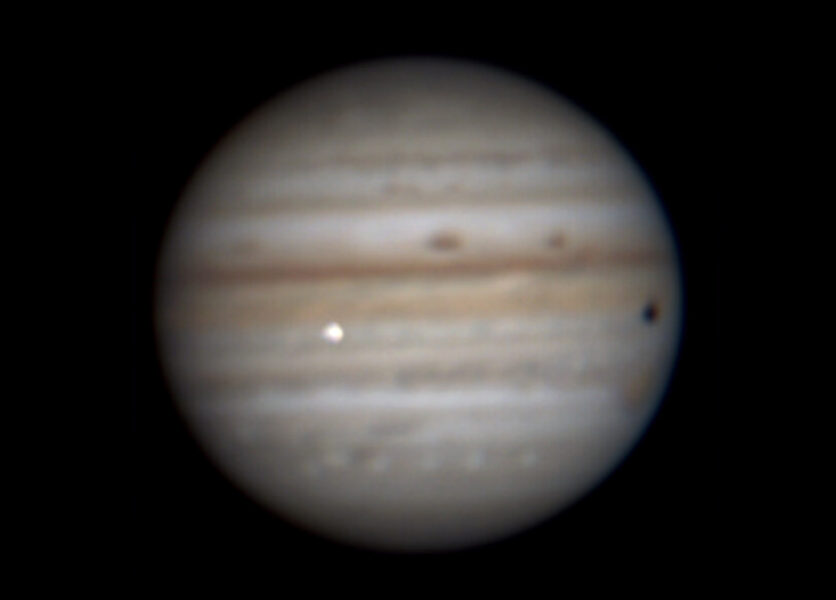
José Luis Pereira
Did Jupiter just get smacked again? Amateur astronomer José Luis Pereira of Brazil just discovered a probable new impact at the gas giant on September 13th at around 22:39:30 UT (18:39:30 EDT). Weather conditions were poor at the time, but Pereira decided to search anyway for possible flashes with DeTeCt software. The free program, created by planetary observer Marc Delcroix, is a useful tool to check for transient events such as planetary impacts.
José Luis Pereira
Despite poor conditions Pereira suspected something on his first video and ran DeTeCt to check it out. The program alerted him that there was a high probability that what he saw was indeed a collision. He immediately sent a message to Delcroix for confirmation.
If confirmed, it would be the tenth recorded impact at Jupiter since the first in July 1994, when fragments of sundered Comet Shoemaker-Levy 9 slammed into the planet and left a trail of prominent dark scars. That number includes a minor strike spotted by NASA's Juno probe on April 10, 2020.
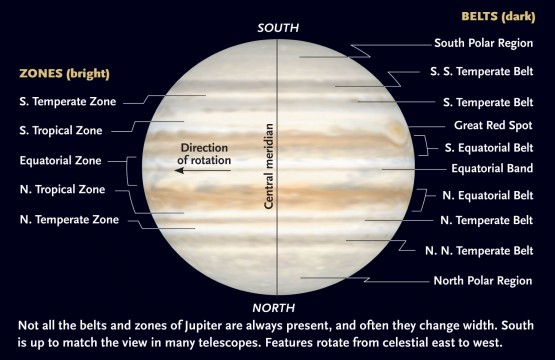
Sky & Telescope
Jupiter rotates rapidly, coming round in just under 10 hours. To find a potential dark spot in the impact's wake, you'll need to know its latitude and longitude. But because the planet isn’t a rigid body, its rotation rate varies some by latitude. Equatorial regions spin fastest and polar regions slower. That’s why three systems are used to determine a feature's longitude: System I for locations within 10° of the equator (for the current flash), System II for all higher latitudes, and System III to match the rotation of the planet’s magnetosphere and Jupiter’s official rotation rate. Often, all three longitudes will be given for completeness.
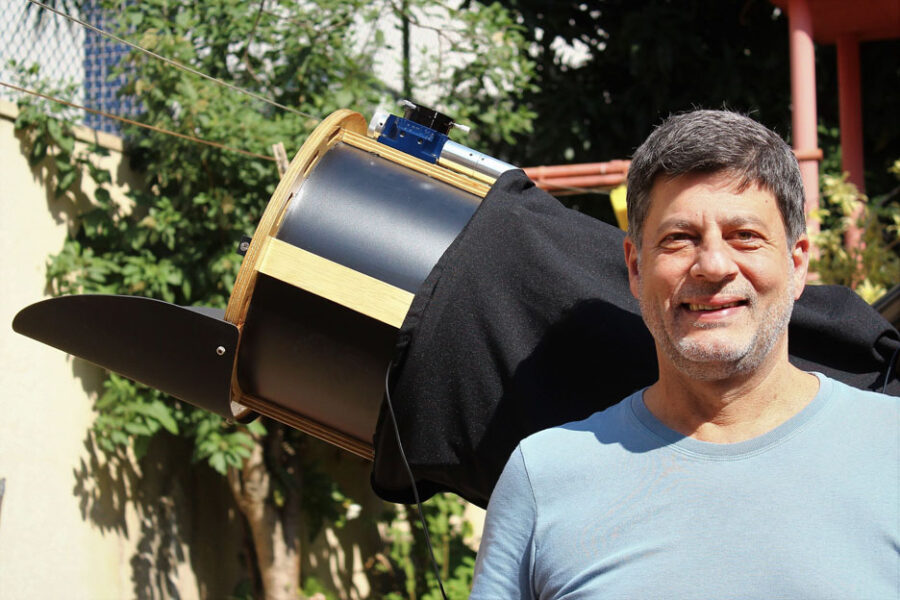
José Luis Pereira
Pereira captured the flash at latitude –5.5° and longitude 105.7° (System I / L1), 83.3° (System II / L2), and 273.4° (System III / L3). To determine the current or a future Jovian longitude in either system, use the Arkansas Sky Observatory’s Jupiter Central Meridian site and input the desired UT time. Click here to convert your local time to UT.
Amateurs are encouraged to check any videos or photographs taken within 5 minutes of the impact time to confirm the event. I also hope you’ll be watching the site for any impact scar that might appear in the coming nights. Happily, a dark marking should stand out well against the pale Equatorial Zone.
This is a developing story. Updates are found below.
** Update September 15 — At least 7 observers independently saw or recorded the flash according to Marc Delcroix. That includes 1 from Brazil, 2 from Germany, 3 from France and 1 from Italy. You'll find the French videos and still photos here.
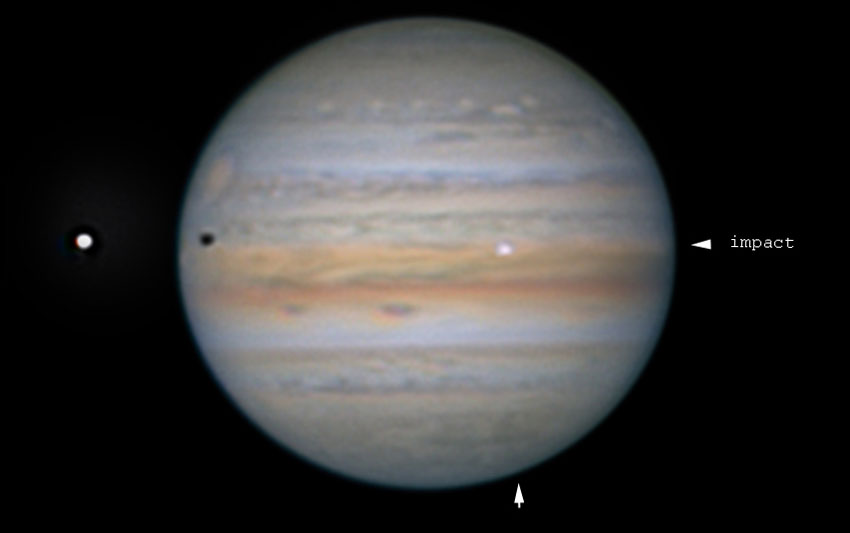
Harald Paleske
German amateur astronomer Harald Paleske also captured images of the impact through his 16-inch reflector. Despite poor seeing at the time, the 2-second-long flash is obvious. I've seen a rough estimate of 100 meters (328 feet) for the impactor's size. There are no reports of dark impact spots at this time.
** Update September 20, 2021
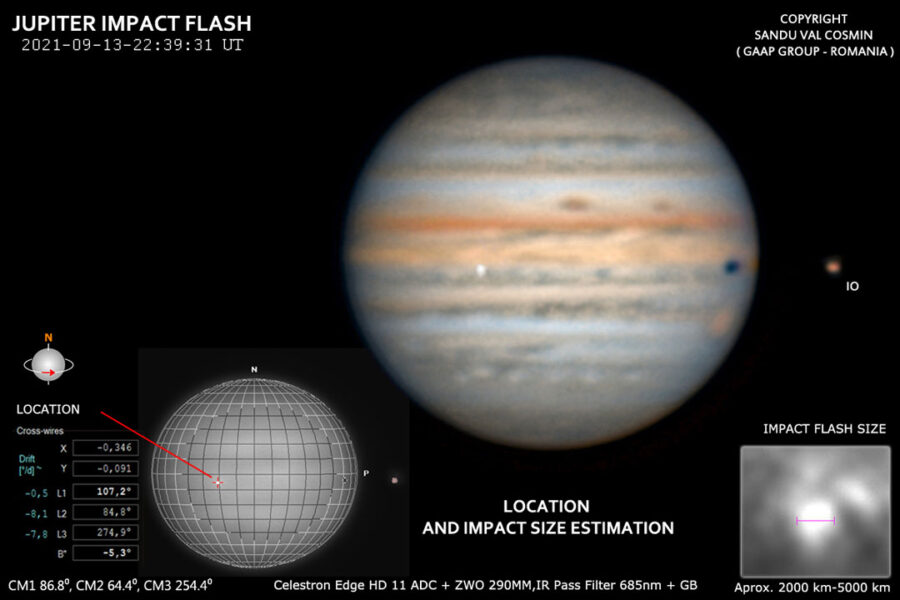
Sandu Val Cosmin
There are still no reports, either visually or photographically, of impact spots, however Romanian amateur Sandu Val Cosmin can add his name to the short list of amateurs who captured the flash. He was photographing the transit of Io at the time and noticed a "large, rapid spark" in his IR filter toward the end of the observation. He realized its importance the following day when the Brazilian amateur José Luis Pereira shared his captures of the impact.
Cosmin writes: "Although I am (at) the beginning of the exposures to the planets, being focused on the deep-sky pictures, I think I was very lucky to catch this event."
We agree. Congratulations to Cosmin and all the other amateurs who captured this amazing sight!
 12
12









Comments
Anthony Barreiro
September 14, 2021 at 10:16 pm
Spaceweather.com reported that German astronomer Harald Paleske observed an impact at 22:39:27 UT on Sept. 13th. The spaceweather.com report includes Paleske's image, and unfortunately either Paleske or spaceweather seems to have mistakenly reversed latitude and longitude, reporting latitude 106.9° (CM1), and longitude +3.8°.
Here's the spaceweather report:
https://spaceweather.com/archive.php?view=1&day=15&month=09&year=2021
You must be logged in to post a comment.
Bob KingPost Author
September 15, 2021 at 12:22 am
Hi Anthony,
That's strange — yes, it appears Spaceweather is in error and reversed the numbers. The values I used come direct from José Pereira through personal communication.
You must be logged in to post a comment.
[email protected]
September 15, 2021 at 4:47 pm
Hi , my name is Adina I'm not as experienced as you but I have a Q why the asteroid or comet whatever it was had no trail? When Schewmaker-Levy9 blasted good ol' Jupiter A. It had trails all 9 pieces plus the aftermath it looked dark not shiny. Why is that ? Ty.
You must be logged in to post a comment.
Bob KingPost Author
September 15, 2021 at 4:56 pm
Hi Adina,
Great question! The reason is because astronomers discovered Shoemaker-Levy 9 when it was a comet, predicted its collision with Jupiter and then watched as big fragments of the comet created dark impact scars in Jupiter's cloud tops. In this case, no one knew in advance when this latest impact would occur. That's probably because it was a single, relatively small object. Impacts happen at Jupiter all the time, but most are small objects and certainly many are missed. It was dedication and luck that led amateurs to spot this one. And while it produced a flash, not all impacts create obvious dark patches like S-L9. It depends on the size and speed of the impactor. That's not to say a blotch, however big or small, won't develop in the wake of the bright flash in the coming days. That's why we're all watching the planet closely right now through our telescopes. I encourage you to click the link in the story "8th recorded impact" to learn more about previous hits.
You must be logged in to post a comment.
Alain Maury
September 15, 2021 at 9:49 pm
The french amateurs and videos are visible here : https://www.cieletespace.fr/actualites/3-telescopes-amateurs-francais-detectent-un-impact-sur-jupiter
You must be logged in to post a comment.
Alain Maury
September 15, 2021 at 9:50 pm
I meant the french amateurs photos and videos...
You must be logged in to post a comment.
Bob KingPost Author
September 16, 2021 at 12:22 am
Excellent, thank you, Alain!
You must be logged in to post a comment.
vanquirius
September 16, 2021 at 6:54 pm
Hi there! How big would you estimate the impact object to be?
You must be logged in to post a comment.
Bob KingPost Author
September 17, 2021 at 12:00 am
Hi vanquirius,
The best estimate I've heard — and it's just a rough estimate — is 100 meters or 328 feet.
You must be logged in to post a comment.
whwiii
September 18, 2021 at 2:23 pm
just for fun, i attempted to image the impact site and check the location using the arkansas site you list. imaging on 9/16/21 at 04:28 UTC seemed to be in the ballpark according to the site, but when i attempt to locate the spot using winjupos' ephemerides viewer, the location seems way off. i assume i need to enter a recent CM central transit time in winjupos. do you know where i can find that information?
more info:
https://www.cloudynights.com/topic/789795-help-with-jovian-longitude-and-win-jupos/
thanks
You must be logged in to post a comment.
Bob KingPost Author
September 18, 2021 at 2:51 pm
Hi William,
I'm going to find the drift rate and direction of the impact location. As soon as I have it, I'll post it here. Thank you for asking.
You must be logged in to post a comment.
whwiii
September 18, 2021 at 7:08 pm
think i've found the problem. the Arkansas Sky Observatory’s Jupiter Central Meridian site gives the same values no matter what time you enter, so appears to be obsolete. the good news is that i was able to confirm the L1 location given in your article in winjupos using the time of the original sighting. so the win jupos epherides are correct. the bad news is winjupos also shows the impact location at my observation time was not visible.
You must be logged in to post a comment.
You must be logged in to post a comment.